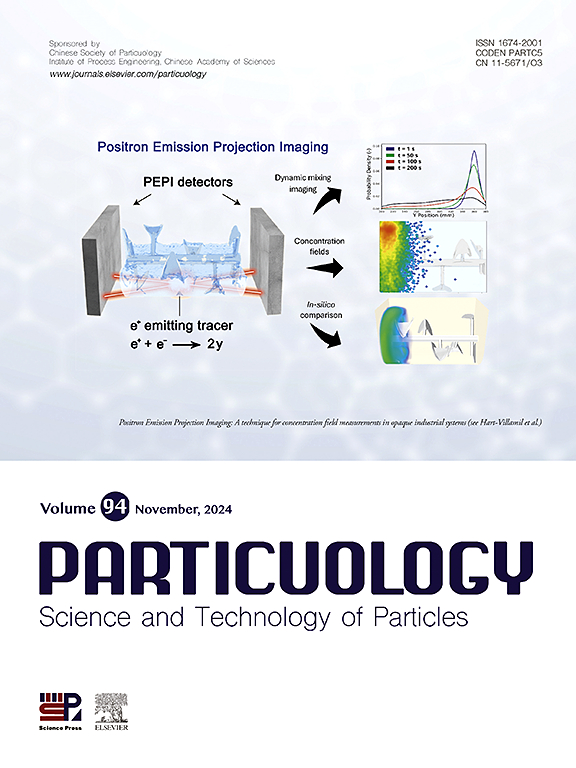Particle dynamics in linear and non-linear magnetic fields: An IBM-DEM coupled analysis
IF 4.3
2区 材料科学
Q2 ENGINEERING, CHEMICAL
引用次数: 0
Abstract
A two way coupled Immersed boundary method (IBM) and Discrete element method (DEM) is performed in this work to access the behavior of particles in Magnetorheological fluids (MRFs) under the influence of magnetic field. Particle dynamics under linear and non-linear magnetic field is analyzed in different conditions. The results are compared with analytical solution for the case of one-dimensional particle motion. Particle chain formation for mono-dispersion and poly-dispersion (having three different sizes) is simulated when particles are placed in lower (0.0375T) and higher (0.3T) density magnetic fields. Particle placed in a stationary fluid column in non-linear magnetic field, along with gravitational force acting on the particle, is also simulated at the end. A modified version of Foam extend (for IBM), is used to compute the hydrodynamic stress which is transferred to the DEM part. The particle position and velocity are then numerically accessed using in-house developed XDEM code (Extended DEM). The new position and velocity of the particles are transferred back to IBM, and this keeps repeating till the final time step. A module is added to the calculate the effect of magnetic force on the particles in XDEM which is then validated with a benchmark case. For particle under linear magnetic field, the chain formation time for 5 μm size particle diameter and mixture of 5 μm, 4 μm, and 3 μm particle diameters with 10%, 20%, and 30% volume concentration (vc.%) is discussed. It is found that for 0.0375T of field density, the particle chain formation for mono-dispersion with 10 vc.% requires more time while for 30 vc.% it is very less relatively. For poly-dispersion, the particle chain formation depends on the random position of particles and the vc.%. For particle suspended in fluid under non-linear magnetic field, the influence of particle dynamics is sever which can overcome the gravitational force effect.

线性和非线性磁场中的粒子动力学:IBM-DEM耦合分析
本文采用浸入边界法(IBM)和离散元法(DEM)的双向耦合方法,研究了磁场影响下磁流变液(mrf)中粒子的行为。分析了不同条件下粒子在线性和非线性磁场下的动力学特性。结果与一维粒子运动情况下的解析解进行了比较。将颗粒置于低(0.0375T)和高(0.3T)密度磁场中,模拟了单色散和多色散(三种不同尺寸)的颗粒链形成。在非线性磁场中,将颗粒置于静止流体柱中,并模拟了作用在颗粒上的重力。使用改进版的Foam extend (IBM)来计算传递到DEM部分的水动应力。然后使用内部开发的XDEM代码(扩展DEM)对粒子位置和速度进行数值访问。粒子的新位置和速度被传递回IBM,这样一直重复,直到最后一个时间步骤。在XDEM中增加了磁力对颗粒影响的计算模块,并通过基准算例进行了验证。对于线性磁场下的颗粒,讨论了5 μm粒径和5 μm、4 μm和3 μm粒径的混合物,体积浓度分别为10%、20%和30% (vc.%)时的链形成时间。结果表明,在0.0375T的场密度下,颗粒链的形成以10 vc为单色散。%需要更多的时间,而30 vc。它相对来说是非常少的。对于多色散,粒子链的形成取决于粒子的随机位置和vc.%。对于悬浮在非线性磁场下的粒子,粒子动力学的影响很小,可以克服重力效应。
本文章由计算机程序翻译,如有差异,请以英文原文为准。
求助全文
约1分钟内获得全文
求助全文
来源期刊

Particuology
工程技术-材料科学:综合
CiteScore
6.70
自引率
2.90%
发文量
1730
审稿时长
32 days
期刊介绍:
The word ‘particuology’ was coined to parallel the discipline for the science and technology of particles.
Particuology is an interdisciplinary journal that publishes frontier research articles and critical reviews on the discovery, formulation and engineering of particulate materials, processes and systems. It especially welcomes contributions utilising advanced theoretical, modelling and measurement methods to enable the discovery and creation of new particulate materials, and the manufacturing of functional particulate-based products, such as sensors.
Papers are handled by Thematic Editors who oversee contributions from specific subject fields. These fields are classified into: Particle Synthesis and Modification; Particle Characterization and Measurement; Granular Systems and Bulk Solids Technology; Fluidization and Particle-Fluid Systems; Aerosols; and Applications of Particle Technology.
Key topics concerning the creation and processing of particulates include:
-Modelling and simulation of particle formation, collective behaviour of particles and systems for particle production over a broad spectrum of length scales
-Mining of experimental data for particle synthesis and surface properties to facilitate the creation of new materials and processes
-Particle design and preparation including controlled response and sensing functionalities in formation, delivery systems and biological systems, etc.
-Experimental and computational methods for visualization and analysis of particulate system.
These topics are broadly relevant to the production of materials, pharmaceuticals and food, and to the conversion of energy resources to fuels and protection of the environment.
 求助内容:
求助内容: 应助结果提醒方式:
应助结果提醒方式:


